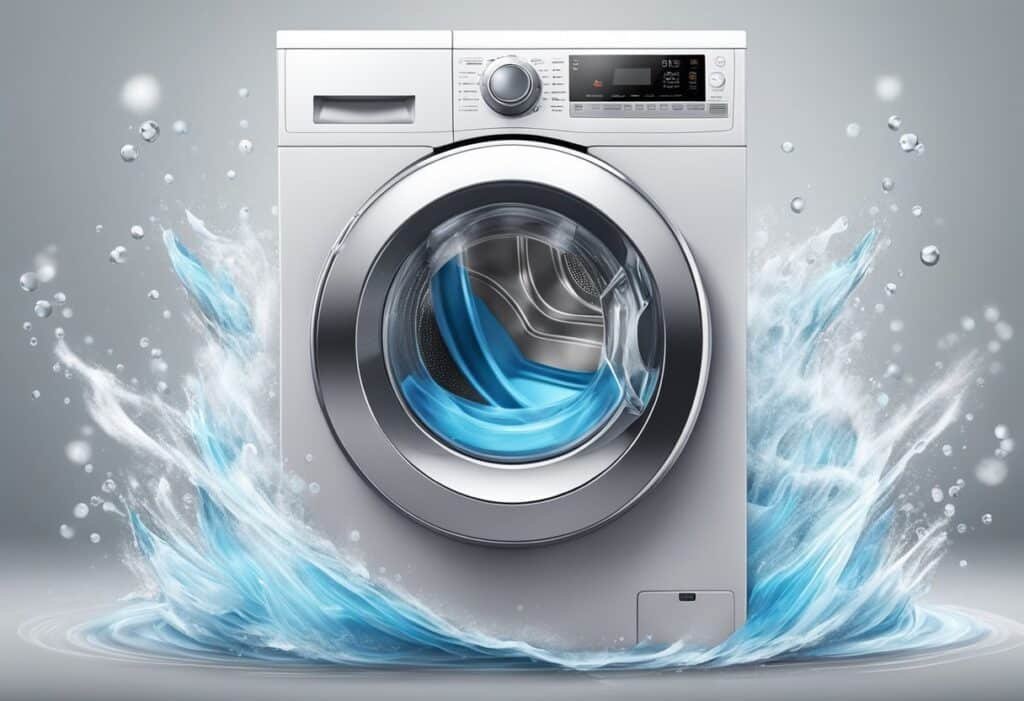Spin speed in a washing machine refers to how fast the drum spins during the final cycle. The faster the spin, the more water is extracted from your clothes. Higher spin speeds help reduce drying time and save energy. So, when choosing, aim for a balance that suits your laundry needs.
If you’re in the market for a washing machine, you might have come across the term “spin speed.” But what exactly does it mean? Put simply, spin speed refers to the number of times the drum of a washing machine rotates per minute. This speed is measured in revolutions per minute (RPM), and it can have a significant impact on the efficiency of your laundry routine.
When you select a spin speed on your washing machine, you’re essentially determining how fast the drum will rotate during the spin cycle. The faster the spin speed, the more water will be removed from your clothes, resulting in shorter drying times. Higher spin speeds are generally more efficient, but they can also be noisier and more expensive. Also, certain fabrics may not be able to withstand high spin speeds, so it’s important to check the care label before selecting a cycle.

Table of Contents
What is Spin Speed in Washing Machines
When you select a wash program and start the washing machine, it first takes in water to wet the clothes. Then, it takes in the detergent along with more water. Once the washing machine has completed the wash cycle, it begins to spin the clothes to remove the excess water. This is where the spin speed comes into play.
The spin speed refers to the number of times the drum rotates per minute. This speed can vary depending on the make and model of the washing machine. The higher the spin speed, the more water is extracted from the clothes, which means they will dry faster.
Most washing machines have a button to adjust the spin speed from zero to its maximum level. The spin speed is measured in revolutions per minute (RPM). The average spin speed for a washing machine is between 600-1200 RPM, but some models can go up to 1600 RPM or higher.
It is important to note that the spin speed can affect how fast your clothes dry. The faster the drum turns, the drier the clothes will be at the end of the cycle. However, a higher spin speed can also cause excessive vibrations and damage your washer if the load is imbalanced. To prevent this, many machines have sensors or automatic adjustment features that can detect and correct imbalances during the spin cycle.

Importance of Spin Speed
When it comes to washing machines, the spin speed is an important factor to consider. It determines how fast the drum rotates during the spin cycle, which affects how much water is removed from your clothes. The spin speed is measured in revolutions per minute (RPM), and the higher the RPM, the faster the drum rotates.
Impact on Drying Time
One of the most significant impacts of spin speed is on the drying time of your clothes. The faster the spin speed, the more water is removed from your clothes, which means that they will dry faster. This can be particularly beneficial if you have a large load of laundry to dry, as it can save you a lot of time and energy.
Effect on Fabric Care
While a high spin speed can be beneficial for drying time, it can also have an impact on fabric care. High spin speeds can cause more wear and tear on your clothes, which can lead to damage over time. For delicate fabrics, it is generally recommended to use a lower spin speed to avoid damage.
It is important to note that different fabrics have different spin speed requirements. For example, cotton can typically handle a higher spin speed than delicate fabrics like silk or wool. It is always a good idea to check the care label on your clothes to determine the appropriate spin speed.
Common Spin Speed Ranges
When it comes to washing machines, spin speed is an important factor to consider. Spin speed refers to the number of times the drum of the washing machine rotates per minute during the spin cycle. Generally, the higher the spin speed, the more water is extracted from the clothes, resulting in faster drying times. In this section, we will discuss the common spin speed ranges found in washing machines.
Low Spin Speed
A low spin speed is typically between 400 and 800 revolutions per minute (RPM). This speed is suitable for delicate fabrics that may be damaged by high spin speeds. Low spin speeds are also recommended for heavily soiled clothes, as a high spin speed may not effectively remove all the dirt and stains.
Medium Spin Speed
A medium spin speed is typically between 800 and 1200 RPM. This speed is suitable for most fabrics and is the most commonly used spin speed. It effectively removes water from clothes without causing excessive creasing or damage to the fabric.
High Spin Speed
A high spin speed is typically between 1200 and 1600 RPM. This speed is suitable for heavy fabrics such as towels, jeans, and other thick materials. High spin speeds extract more water from the clothes, resulting in faster drying times. However, high spin speeds may cause excessive creasing and damage to delicate fabrics.
It’s important to note that the spin speed range may vary depending on the make and model of the washing machine. Some washing machines may have a maximum spin speed of 1800 RPM, while others may have a maximum spin speed of 1400 RPM. Always refer to the manufacturer’s instructions for the recommended spin speed range for your washing machine.
Adjusting Spin Speed
Adjusting the spin speed of your washing machine can have a significant impact on the effectiveness of your wash cycle. Spin speed is measured in rotations per minute (RPM) and refers to how fast the drum spins during the spin cycle. The faster the spin speed, the more water is extracted from your clothes, resulting in shorter drying times. Here are some ways to adjust the spin speed of your washing machine:
Manual Adjustment
Most washing machines have a manual adjustment feature that allows you to select the spin speed based on the type of load you are washing. You can adjust the spin speed by selecting the appropriate setting on the control panel of your machine. For example, if you are washing delicate fabrics, you may want to choose a lower spin speed to prevent damage to the clothes. On the other hand, if you are washing heavy-duty items like towels or jeans, you may want to select a higher spin speed to extract more water.
Pre-Set Programs
Many washing machines also come with pre-set programs that automatically adjust the spin speed based on the type of load you are washing. These programs are designed to optimize the washing cycle for different types of fabrics. For example, a delicate cycle may have a lower spin speed to prevent damage to the clothes, while a heavy-duty cycle may have a higher spin speed to extract more water.
It is important to note that not all washing machines have the same pre-set programs, so it is important to read the manufacturer’s instructions to understand which programs are available on your machine. Additionally, some machines may allow you to customize the pre-set programs to adjust the spin speed to your specific needs.
By adjusting the spin speed of your washing machine, you can ensure that your clothes are washed effectively and efficiently. Whether you manually adjust the spin speed or use pre-set programs, understanding how to adjust the spin speed can help you get the most out of your washing machine.

Spin Speed and Energy Efficiency
When it comes to washing machines, spin speed refers to the number of revolutions per minute (RPM) that the drum makes during the spin cycle. The higher the spin speed, the more water is extracted from your clothes, resulting in shorter drying times.
However, it is important to note that higher spin speeds also mean higher energy consumption. According to Consumer Reports, washing machines with higher spin speeds tend to use more electricity than those with lower spin speeds. This is because the motor needs to work harder to achieve higher RPMs, leading to increased energy consumption.
To make sure you are using your washing machine in the most energy-efficient way possible, it is recommended to use the highest spin speed that is appropriate for the type of fabric you are washing. For example, delicate fabrics such as silk or lace should be washed at lower spin speeds to avoid damage, while heavier fabrics like jeans or towels can be washed at higher spin speeds.
Another way to increase energy efficiency is to make sure you are not overloading your washing machine. Overloading can cause the motor to work harder than necessary, leading to increased energy consumption. Be sure to follow the manufacturer’s guidelines for load size and weight.
Spin Speed and Noise Levels
When it comes to washing machines, spin speed is an important factor to consider. The spin speed of a washing machine refers to how many times the drum rotates per minute during the spin cycle. The higher the spin speed, the more water is extracted from your clothes, resulting in shorter drying times. However, it’s important to note that a higher spin speed can also result in more noise.
If noise is a concern for you, it’s important to pay attention to the decibel (dB) rating of the washing machine. A washing machine with a lower dB rating will be quieter than one with a higher rating. For reference, a washing machine with a dB rating of 50 is about as loud as a quiet conversation, while a washing machine with a dB rating of 70 is about as loud as a vacuum cleaner.
To help you choose a washing machine with an appropriate spin speed and noise level for your needs, we’ve compiled a table of popular washing machine models and their corresponding spin speeds and dB ratings:
Model | Spin Speed (RPM) | Noise Level (dB) |
|---|---|---|
LG WM9000HVA | 1300 | 44 |
Samsung WF45K6500AV | 1300 | 53 |
GE GTW720BSNWS | 800 | 48 |
Whirlpool WFW6620HC | 1200 | 53 |
Keep in mind that these ratings are just a guide, and your personal preferences may vary. It’s always a good idea to read reviews and do your research before making a purchase.
Select the Right Spin Speed for Your Laundry
When it comes to washing your clothes, choosing the right spin speed can make a big difference in the quality of your laundry. Spin speed is the rate at which your washing machine drum rotates during the spin cycle. The higher the spin speed, the more water is extracted from your clothes, resulting in shorter drying times and less energy consumption.
To help you choose the right spin speed for your laundry, here are some guidelines:
1. Delicate Fabrics
Delicate fabrics such as silk, lace, and wool should be washed on a low spin speed to prevent damage. A spin speed of 400-600 RPM is ideal for these fabrics. You can also use a delicate or hand wash cycle to further protect your clothes.
2. Synthetic Fabrics
Synthetic fabrics such as polyester, nylon, and spandex can be washed on a higher spin speed of 800-1000 RPM. These fabrics can withstand higher speeds without getting damaged.
3. Cotton and Linen Fabrics
Cotton and linen fabrics are more durable and can handle a higher spin speed of 1000-1200 RPM. This will help to remove more water from the fabric and reduce drying time.
4. Heavy Duty Fabrics
For heavy duty fabrics such as towels and jeans, a spin speed of 1200-1400 RPM is recommended. This will help to remove tough stains and dirt from the fabric.
It’s important to note that not all washing machines have the same spin speed options. Make sure to check your machine’s manual or settings to see what spin speeds are available. By choosing the right spin speed for your laundry, you can ensure that your clothes are clean and well-cared for.
Frequently Asked Questions
What are the advantages of a higher spin speed in a washing machine?
A higher spin speed in a washing machine can help to remove more water from your clothes, resulting in shorter drying times. This can save you time and energy, and it can also help to reduce wear and tear on your clothes. Additionally, a higher spin speed can help to remove more dirt and stains from your clothes, resulting in cleaner laundry.
Can high spin speeds cause damage to clothes?
While high spin speeds can be beneficial for removing water and dirt from clothes, they can also be damaging if used improperly. Clothes that are too delicate or lightweight may become damaged or stretched if spun at high speeds. It is important to always check the care label on your clothes to determine the appropriate spin speed.
How does spin speed affect the drying time of laundry?
The higher the spin speed, the more water will be removed from your clothes, resulting in shorter drying times. However, it is important to note that the drying time will also depend on other factors such as the type of fabric, the humidity, and the temperature of the room.
What is the optimal spin speed for washing towels and heavy textiles?
Towels and heavy textiles such as bedding and curtains should be washed at a higher spin speed to remove as much water as possible. A spin speed of 1400 RPM or higher is recommended for these types of items.
Are there benefits to washing machines with 1600 RPM over 1400 RPM?
Washing machines with a higher spin speed of 1600 RPM can remove more water from clothes, resulting in shorter drying times. However, it is important to note that there may be little difference in the actual drying time between washing machines with a spin speed of 1400 RPM and those with a spin speed of 1600 RPM.
What should be considered when choosing the spin speed for different fabrics?
When choosing the spin speed for different fabrics, it is important to consider the care label on the clothes. Delicate fabrics such as silk and lace should be spun at a lower speed, while heavier fabrics such as towels and bedding can be spun at a higher speed. It is also important to consider the age and condition of the washing machine, as older machines may not be able to handle high spin speeds.



